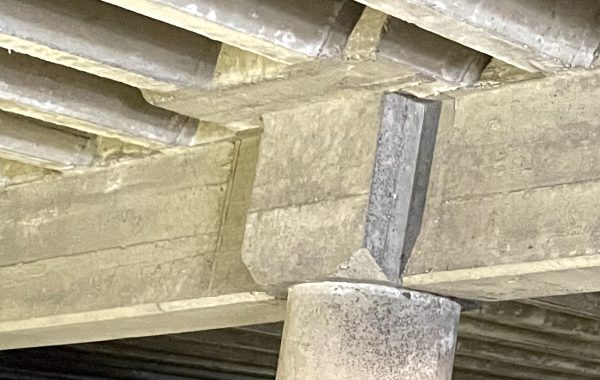Last spring I wrote six posts on the topic of modeling. I was thinking about that topic today and realized that I had omitted an important portion of the discussion, so here we are. Since, as I described at some length in the earlier posts, all models are inaccurate to some degree, there is no perfect modeling method. There are popular methods, but that popularity does not mean they are better in all aspects or all circumstances.
Say that I’m interested in looking at the strength of the columns in a steel frame for their capacity to carry wind load on a ten-story building, which is the problem that John Kirkham was solving in the textbook page I’ve copied above. I have multiple options in performing that analysis:
- A really crude analysis would be to treat the entire building as a cantilever beam stuck in the ground and simply calculate the vertical forces in the columns based on their distance from that beam’s neutral axis. This would be badly inaccurate for stresses, since it ignores the bending in the columns created by the fact that this is a frame rather than a beam. But it’s very fast. It also can provide fast and badly inaccurate estimates of lateral deflection.
- The formal “cantilever method” also treats the building as a big cantilever beam, but computes the bending in the beams and columns caused by lateral loading and so gives a reasonably accurate picture of the overall stress in any member. It does not provide useful information on defection (lateral drift). This method requires a fair bit of calculation, but nothing that couldn’t be done in a day (with a calculator at hand) for this building. This is the method Kirkham was demonstrating.
- The “portal method” is similar to the cantilever method, but makes slightly different starting assumptions.
- “Moment distribution” is a more accurate method that uses iteration to remove the bias created by initial assumptions. More math required than methods 2 and 3, but still reasonably done by hand.
- The various flavors of the “finite element method” are much more accurate and can provide accurate estimates of lateral drift. The theory behind this method has been around for a while, but it only gained popularity when computing became inexpensive, as it is simply too much work to reasonably perform by hand. It’s the default choice today.
At first glance, FEM, the fifth method, seems to be the best choice. More information provided and more accurate. But everything in engineering is a trade-off, and using FEM all the time puts distance between the engineer and the structural model, and subtly changes the focus of thinking. “How do I get the computer to give me acceptable output?” is a different question than “how do I change the model to get the performance I want?” In some ways, the ease of repeatedly re-running an FEM model short-circuits thinking about why the model is behaving the way it is.
Everyone has to decide what option they want to use. Me personally, I use the first method to get an order-of-magnitude answer in twenty minutes; I’ve used 2, 3, 4, and 5 for final answers, although obviously 5 more than the others. Very complex frames may require only FEM analysis; I wish people would branch out more with simple ones, as a way to get a better feel for how frames act.



